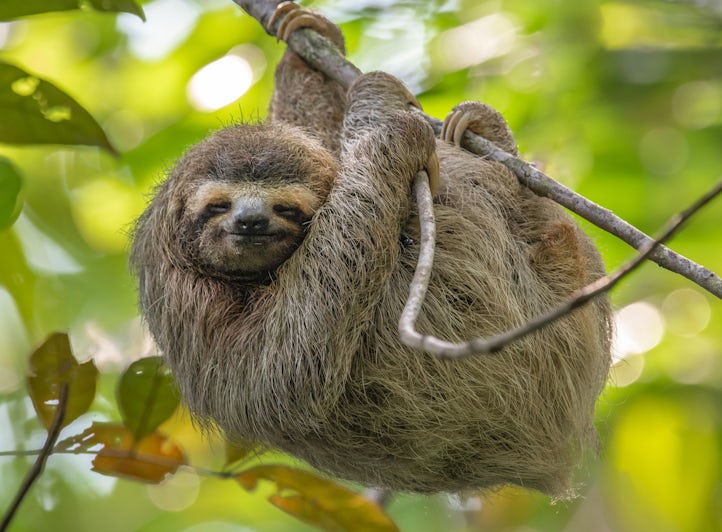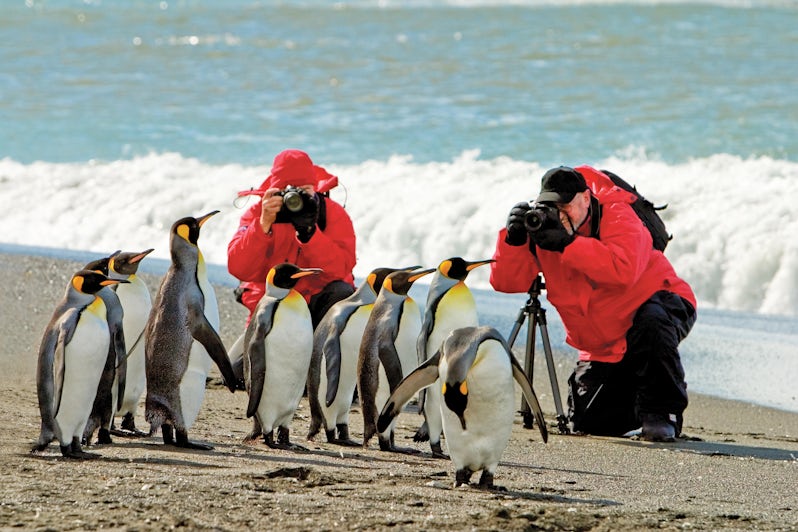
16 Cutest Animals You Can See on a Cruise


Whether you're having the best day or the worst, who doesn't love pictures of adorable animals? Embrace the cuteness with our recap of some of the most fluffy, feathery creatures you can find on cruises to a number of destinations. They're guaranteed to make you say "awww."
On This Page
- Otters (Alaska)
- Dolphins (Caribbean)
- Red foxes (Mediterranean)
- Moose (Canada/New England)
- Blue-footed boobies (Galapagos)
- Polar bears (Arctic)
- Sloths (Central/South America)
- Sea lions (Mexico)
- Pandas (Asia)
- Puffins (Baltic)
- Camels (Middle East)
- Quokkas (Australia)
- Penguins (Antarctica)
- Tamarins (Central/South America)
- Baby lions (Africa)
- Towel animals (select lines)
1. Otters (Alaska)

These land-and-sea mammals are found just about everywhere, but you can easily spot them in Alaska, along with many other animals. They lack a fatty layer to keep them warm in the water and instead rely on thick, well-groomed fur for insulation. They're experts at fishing and, like many a cruiser, opt for only the finest seafood, including crustaceans and other shellfish, which they crack open by banging them against rocks. Otters often intertwine themselves with kelp or -- even cuter yet -- interlock their feet with those of other otters to avoid floating away while sleeping.
2. Dolphins (Caribbean)

There are many types of dolphins, but the most common are the bottle-nosed variety, which you might spot swimming alongside your ship or frolicking in the water nearby as you sail between Caribbean ports like Grand Turk, Grand Cayman, Tortola and others. Intelligent, social and generally good-natured, dolphins live in pods and go out of their way to help members who are old, sick or injured.
3. Red foxes (Mediterranean)

During a visit to the Mediterranean -- ports in France, Italy and Germany, to name a few -- you might spot a red fox or two. You'll also find these fluffy, rust-colored canines on British Isles cruises. (Oddly, they're plentiful in cities like London because they're skilled at adapting to the presence of humans.) Foxes are scavengers and considered pests by many locals, but they're extremely intelligent and can hear a watch ticking from as far as 40 yards away.
4. Moose (Canada/New England)

Moose -- the same word is used when talking about just one or several -- are the largest animals in the deer family, living up to 25 years in the wild and weighing up to 1,500 pounds. In spite of their size, they're efficient swimmers and can run up to 35 miles per hour. They survive on plants, mainly eating tall grasses, shrubs and pinecones. Although you might associate them more with Alaska sailings and pre- or post-cruise tours in the western part of Canada, they can occasionally be spotted on excursions from Bar Harbor and Bangor, Maine, or Saguenay in Quebec.
5. Blue-footed boobies (Galapagos)

Blue-footed boobies, found (along with other interesting animals) in the Galapagos and other subtropical islands in the Pacific, are famous for their blue-hued feet, which get their color from the birds' diet of fresh fish. Blue foots are adept divers, shooting themselves into the water from great heights in order to catch their dinner; their nostrils are permanently sealed to prevent water from entering. When it's time to mate, males perform a funny dance. Their fancy footwork aims to attract females, who are drawn only to males with the richest blue hues.
6. Polar bears (Arctic)

They might look cute, but don't let that fool you. Polar bears are the largest predators of all animals in the Arctic, and they spend their days hunting equally cute animals like seals and whales. Their fur appears white, but it's actually transparent, allowing them to better blend in with the landscape, and their paws are specially designed for swimming and walking on ice without slipping. Polar bears ask permission to share another bear's food by gently touching noses.
7. Sloths (Central/South America)

Sloths are totally having a moment right now -- and rightfully so, given their adorable facial features and laidback attitude. Contrasting with their "Edward Scissorhands"-looking claws, which help them climb the trees in which they spend most of their lives, they have a gentle nature, and their slow movements help them to go undetected by predators. Moths often take up residence on sloths' fur, helping to fertilize a type of algae that grows there because of how slow the sloths move. Although you're most likely to witness sloths in their natural habitat during Amazon river sailings, you can check out these cuddly critters via excursions in ports like Cartagena, Lima, Buenos Aires and others, as well as many in Central America and even Asia.
8. Sea lions (Mexico)

If you're headed to the Mexican Riviera, you're likely to spot these playful creatures, either in port or as part of a shore excursion offering. Not only are they smart and generally friendly, but they're also cute as buttons. Subsisting primarily on fish, shellfish and squid, sea lions slow their heart rates when they dive under water, allowing them to remain below the surface for as long as 10 minutes.
9. Pandas (Asia)

You'll find two types of pandas, both native to China -- the red panda, which is closely related to a raccoon, and the giant panda, which is closely related to a bear. They do share several characteristics with one another, including an affinity for bamboo, but we think the most obvious commonality is that they're undeniably charming.
10. Puffins (Baltic)

Puffins, also known as sea parrots due to their bright coloring, are cute but carnivorous. They prefer dining on fish and eels, which they spend most of their time hunting in open water. During the winter, their brilliant orange beaks turn a gray color before returning to orange again in the spring. Heartwarming fact: Some puffins keep the same mates for as long as 20 years.
11. Camels (Middle East)

Camels, with their soulful eyes, are used for transportation throughout the Middle East, where the one-humped variety is most common. This type of camel can travel up to 100 miles through the desert before needing water, thanks to up to 80 pounds of fat stored in the hump. When rehydration is necessary, camels can drink up to 30 gallons of water at one time. They can be seen in various ports, including Aqaba, Abu Dhabi, Dubai and Doha.
12. Quokkas (Australia)

These nocturnal plant-eaters grow to be about the size of domestic house cats. Like their equally cute Australian neighbors the koala, the kangaroo and the wombat, quokkas are marsupials, which means the females carry their young inside stomach pouches until they mature. Quokkas are found only in certain parts of western Australia and are a protected species there. They aren't afraid of humans, but be warned: you could face a $300 fine if you pet one.
13. Penguins (Antarctica)

Despite Antarctica's reputation for being inhospitable to humans, there are eight penguin species native to the White Continent. Interestingly, these frosty fowl are able to drink seawater, regardless of the salt, to wash down their regular diet of fish. They use a combination of body fat, scale-like feathers and body heat from other penguins to keep warm. If their tuxedo-esque appearance isn't enough to win you over, perhaps their waddling gait will do the trick.
14. Tamarins (Central/South America)

Tamarins are squirrel-sized monkeys native to parts of Central and South America. Three of the most common types are the endangered orange-colored golden lion tamarin; the emperor tamarin, which boasts blackish-gray fur and a long, white mustache; and the Geoffroy's tamarin, which is the smallest monkey in Central America. Tamarins are omnivores, eating insects, fruit, flowers, sap and even small lizards. Your best bet for spotting one is to take an Amazon River cruise or excursions in Rio de Janeiro, Buenos Aires, Lima, Colon and Panama City, among other ports.
15. Baby lions (Africa)

Sure, we think lion cubs are squeal-worthy, but not all creatures agree. Cubs are often killed when groups of male lions attempt to take over a pride. For that reason, lionesses give birth under dense cover, and the babies stay there for up to two months for their own safety before they're introduced to the rest of the group. Cubs begin weaning around 10 weeks, transition fully to meat around 9 to 10 months and acquire hunting skills by age 2. They're considered fully grown between 3 and 4 years of age. The best and most humane way to check out baby lions is to book a safari-specific cruise or to tack a safari on to the beginning or end of an Africa sailing.
16. Towel animals (select lines)

These plush beings are most often found in cruise ship cabins after dinner but have also been known to lurk around the pool deck on certain ships, particularly early in the morning. They routinely steal sunglasses, hats and other small articles of clothing, but their soft, absorbent skin and starchy fragrance make them pleasant companions for many passengers nonetheless. They are often unafraid of humans and are exceedingly photogenic. They eat very little (read: nothing at all), and while they sometimes disappear, leaving other towlies in their place, they can also multiply without warning.